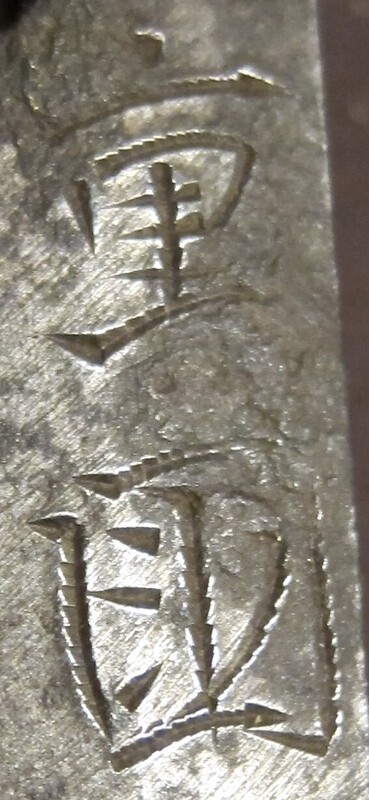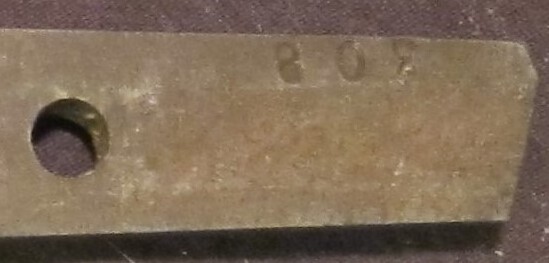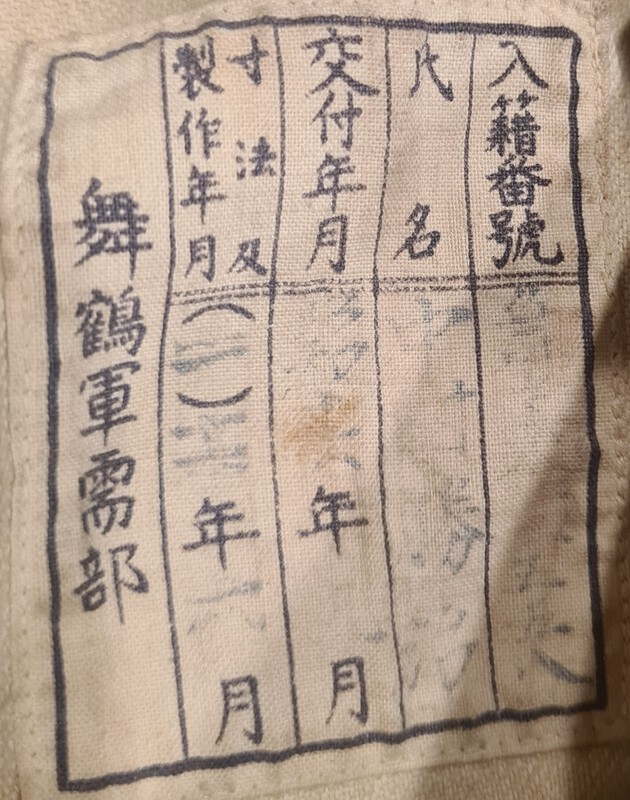-
Posts
2,927 -
Joined
-
Last visited
-
Days Won
16
Content Type
Profiles
Forums
Events
Store
Downloads
Gallery
Posts posted by george trotter
-
-
Had a look through the books Klaus but I found nothing for a WWII era TADAYOSHI of Yamato no Kuni (Nara Prefecture), sorry...I too have a couple of unrecorded WWII smiths...a nuisance for sure!
Regards...
-
 1
1
-
-
Yes, I still have my 1972 copy...mine cost $1.75 Australian.
Great help back in the day...
-
 2
2
-
-
OK, great stuff...thanks David.
I will keep an eye on IMA's auctions in case it comes up...be interested to know what it brings.
Regards...
-
Hi David,
That is great info...thank you. I will "ponder it" and see if I can add anything to your info.
I actually responded to you privately before I saw this post, so please disregard my private message as you answer most of my questions here...just a couple of things...
Is it dated on the tang?
Now many seppa? (8?)
What is the assembly number stamped on the seppas?
Regards,
-
Hi David,
Now 6 days since you asked your question about your WWII Shigekuni and also that long since members here gave you some answers.
Not sure why you don't get back in touch with us...hope you haven't been hit by a bus outside International Military Antiques in Gillette, New Jersey, where you work.
Hope to hear back from you and to see some pics of the blade and any info you have on the officer that owned it...IJA unit...where surrendered etc. Just hoping...
Regards...
-
 2
2
-
-
Hi David,
It has been a couple of days since you posted...I was wondering if we are going to hear back from you regarding your query?
I would like to have info/pics from you regarding your Shigekuni - so I can compare it with mine.
Love to see the blade, whole tang, fittings and whether there are any "mounting shop" marks on your hilt wood etc.
So far as I know, you are the only other collector in the world that has a modern WWII Shigekuni sword.
Here are some hilt marks on mine. 3 in a circle stamp (mounting shop logo?)
kanji numbers 199 (job number?) - tsuba and seppa have roman numbers 199.
Name OSHIMA (customer name - not my officer - maybe the person who ordered the polishing/mounting job?).
Anything on your hilt?
Regards... -
Hi David,
Your Shigekuni signed blade is identical to mine...signature matches exactly. It is written in the style of some of the signatures done by the c.1655 2nd Gen. NANKI SHIGEKUNI of KII province (now Wakayama).
However, this is in fact a WWII gendaito smith and now that you have provided a second example, it seems he made these for military officers, but signed in the style of 2nd Gen Shigekuni. Although modern WWII made, this smith is not recorded in any book I have seen, so other than discuss the quality and date of his (now 2) blades, I have no history of him.
Here are a few photos of mine and his signature and a comparison with the way the 2nd Gen Nanki Shigekuni signed some of his tangs - look especially at the way the 'kuni' is written. I think this WWII Shigekuni deliberately "copied" the writing style of the 2nd Gen.
Hope this helps.
I'd like to see some pics of your blade and fittings...any info on where/who surrendered your blade?
Mine was owned by a 2nd Lt. Kume of the 32nd (Kaeda) Division on Morotai Island in August 1945. This Div. consisted of the 210, 211, 212 Regiments drawn from Tokyo and the adjoining Chiba and Yamanashi Prefs. It was raised and trained in Feb 1939 - May 1939 (so the officer probably came from one of these three areas and as they all trained in Tokyo, this is probably where he engaged the smith Shigekuni to make his sword). Lt Kume surrendered to the Americans and Australians on Morotai in two separate ceremonies...he was obviously part of the units that surrendered to the Australians as it ended up here after the war.
Be great to know more about this Shigekuni....look forward to your pics of blade/tang/fittings etc.
On the handle wood (under the Fuchi) is a ink stamp "3 in a circle" mon (prob. the mounting/polishing/artisan logo, and also the kanji numbers '199' (prob the job number) and the name 'Oshima' (prob the name of the mounter guy?). Maybe check yours and see if yours went through the same "system".
My officer's silver mon was torn off before its surrender.
-
 3
3
-
 3
3
-
 2
2
-
-
Almost right Klaus...Okimasa is the younger brother of Masakazu. Although youngest, Okimasa was the first of 4 brothers to become an independent swordsmith c.1939 and he then took his 3 elder brothers as his apprentices...Masakazu becoming independent in 1941. I think all 4 became RJT.
Regards...
-
 2
2
-
 1
1
-
-
It is a possibility Bruce...But, as I am not the messiah...it would be good if one of our 'fluent' Japanese speakers/readers could have a look through some modern Gendaito sources and see if they mention any of the marking procedures of WWII RJT.
Regards...
-
2 hours ago, Bruce Pennington said:
Thanks Oliver!
I think you're right, Thomas. I have another of his, same date, タ2374 with star, and was wondering about him making that many blades in the same month - 177 - but I also have a similar situation with him, 201 numbers apart in the same month, the previous year
1943, Mar
Niigata
Akihisa (RJT)
松 618 RS star
Schmucker Collection
1943, Mar
Niigata
Akihisa (RJT)
松 819 RS star
Vajo, Trotter Survey
So maybe he had a team making blades for him.
Just thought I'd 'chip in' here...
I don't have exact detail on the Niigata RJT system but I do have a good book on the RJT system in adjoining Fukushima (GUNTO KUMIAI SHIMATSU). This book (p.58-59) gives details on the RJT smith outputs and a Fukushima RJT smith called Tsukamoto Masakazu put out the following:
1944 August 14 -Sept.20 = 10 swords
1944 Sept. 20 - Nov. 19 = 25 swords
1944 Nov. 19 - Dec. 29 = 15 swords
1944 Dec. 29 - 1945 Feb. 26 = 12 swords.
This is a total of 62 swords over about 6 months...while the average is about 10/month it can be seen that the total goes up and down quite a bit...maybe due to Tamahagane supply problems etc?.
This being a pretty clear picture of an RJT smith monthly output, it seems to me that the "giant leaps" in tang numbers might be explained by the numbers being put on tangs by the polishing or mounting shops that serviced the smiths' blades...this might show that the particular smiths blades came in "from time to time" and the numbers show the larger quantity of blades that have passed through these shop between each smiths blade arriving?
Not sure if this helps at all but it does show that the average smith put out approx. 10 swords / month...maybe this can 'fit' in to the tang numbers seen?
Regards,
George.
-
 1
1
-
 2
2
-
-
1 hour ago, Simon R said:
Hi George,
I have to rely on my wife's help to translate passages from each book but I will definitely keep an eye out in the military themed books!
Thanks Simon. I don't know of any recent book themed specifically on RJT but if you come across one, I would be interested....so let us know if you do.
Thanks.
-
Nice collection Simon. Any books there about WWII Rikugun Jumei Tosho?
I'd be interested ...
Regards,
George.
-
15 hours ago, Bruce Pennington said:
Certainly does, thanks George!
forgot to add...all fittings on Munetoshi 308 are numbered '2'.
-
 1
1
-
-
-
RIP Rich.
Your life and contribution will always be appreciated by all of us on NMB.
Warmest memories and thanks...
-
 2
2
-
-
This might help.
Oshigata is of Kasama Shigetsugu tanto with sunagashi (Nihonto Zukan by Tokuno p.167).
Photo is of my blade by Tsukamoto Masakazu 1942. Masakazu was bro. to his teacher Tsukamoto Okimasa who was taught by Kasama Shigetsugu.
It seems that Shigetsugu's style of sunagashi appears in the work of his student Okimasa and in the work of his student Masakazu.
I don't know how many varieties of sand lines are in the classification sunagashi, but this style I show here is called sunagashi by Tokuno.
Regards.
-
 1
1
-
-
Thanks for your kind words Colin...glad to help.
Like you I have had covid and like Stephen I have old-age knees and hip etc...that's life.
You are lucky to find a star stamped RJT smith from Seki, they are not common (mostly showato from there). I too was lucky to find one Seki RJT blade - by Nakata Kanehide.
Love the RJT smiths and their swords.
Regards,
-
 3
3
-
 1
1
-
-
Hi Colin,
I stand to be corrected (I have a bit of a struggle with the pics) but I think it says:
Star stamp, Seki ju Takeyama Yoshinao saku (red paint 49).Date is Showa 20 year 2nd month (Feb 1945).
Hope this helps,
edit: everyone beat me...
-
 2
2
-
 2
2
-
-
On 10/2/2023 at 11:23 AM, Bruce Pennington said:
Interesting. Can't say I've seen (or noticed) nagashi in that location.
Yes Bruce, common in both locations, even into the WWII period (don't know about post-war swords as I don't collect them)..
I have 3 WWII blades with nagashi lines in both locations.
Two are by Yamagami Munetoshi of Niigata and both have 7 nagashi lines under the habaki with 6 lines on the tip (one is private order Type 98 dated 1941 and the other is RS mounted with RJT star, dated 1943).
My third one is private order RS by Tsukamoto Masakazu of Fukushima dated 1942 with 6 lines under the habaki and 6 on the tip.
My other 6 WWII military gendaito don't have them.
Hope this helps.
Edit to add...in case some members have not seen these marks, the description 7 lines under the habaki means seven on each side...and 6 on the tip means 3 on each side of the ridge...just to be clear.
-
 1
1
-
 1
1
-
-
Yes, I read it the same way.
Regards...
-
 1
1
-
-
Nice work Bruce...looks like (in general) the split between Type 98 and RS with brown GUNZOKU tassel is about 50 / 50...with a few 'odds & ends'.
Regards...
-
 1
1
-
-
Many thanks Matt...too bad there was no additional history but I appreciate you trying,
Warm regards,
George.
-
Thanks guys...that helps.
-
Hi all,
I am away from home so no books. I was asked by an elderly gentleman to translate these details in a navy capo.
I can read the name NAKAMURA KATSUHARU and some of the faded numbers etc, but could you guys tell me what the printed boxes say and also what the faded numbers/months/years are?
Thanks...


















WW2 Japanese NLF sword
in Military Swords of Japan
Posted
Hi Steve,
I don't think you will have a devalued sword there as there are a number of variations in the "NLF" mounts and it will be the blade that determines the value.
Any chance of telling us / showing us some more about the mounts and blade?
Regards...